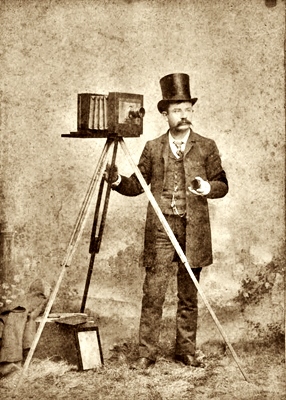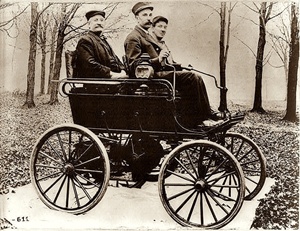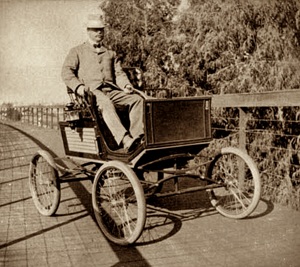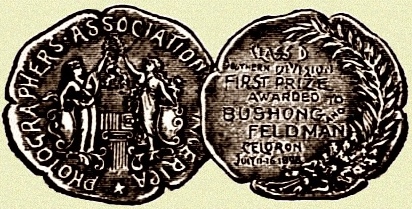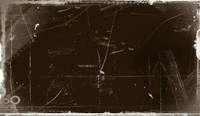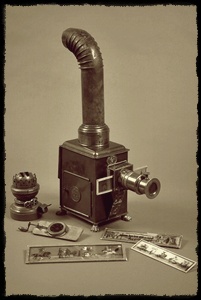
|















|
|
John Chester Bushong
Photographer
By Rick Bushong
March 2014
|
Chester Bushong, taken at the Bushong & Gray Studios, Van Alstyne, Texas. Notice the camera's lens has no shutter. Light was controlled by taking off and replacing the lens cap, (in Chester's hand).
|
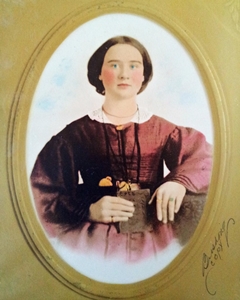 Samantha Violetta Rice Bushong, Chester's mother. The signature is Chester's, indicating it was his studio's copy.
Samantha Violetta Rice Bushong, Chester's mother. The signature is Chester's, indicating it was his studio's copy. |
|
John Chester Bushong was born on a Sunday, September 12, 1869, near Columbus Grove, Putnam County, Ohio. But his quest for knowledge and his passion for photography would take him many places. Truly a man for all seasons he was successful in many pursuits, a few of which are, Inventor, Entrepreneur, Artist, Musician, Bicycle Racer, Bronco-rider, and Photography. He worked until the day he died, December 20, 1938, in Worcester, Worcester County, Massachusetts.
BUSHONG LINEAGE: John Chester Bushong/ John Stout Bushong and Samantha Violetta Rice/ James S. Bushong and Drusilla Stout/ George Bushong and Lydia Rush/ John Bushong* and Jenette Young Summers/ Anthony Andrew Bushong and Catherine Bushong/ Johann Nicholas Bushong and Anna Magdalena Schaffner (the immigrants)/ Hanss John Boschung (III) and Anna Maria Boschung of Switzerland, (immigrated before 1719)/ Hans Boschung (II) and Anna Stocker/ Hans Boschung (I) and Anna Anneler/ Michael Studer-Boschung and Dichti Jaggi.
*Traditional lineage - DNA analysis show a distinct possibility George may have been adopted.
He was called J.C. and sometimes, John, but usually went by his middle name, Chester. He began his life and his education in Columbus Grove, attending public schools. But that changed around 1878 when he was not yet 10 years old. Because his parents, John Stout Bushong and Samantha Violetta Rice, and the family moved to Collin County, Texas. Initially, they lived in McKinney, but after a few months they moved to Celina in the same county.1 Life was difficult for the new arrivals, and in 1879, Chester's infant brother died when just three months old. Then his seven-year-old sister died in 1881.2 But Chester seemed to thrive while he continued his schooling in Celina public schools.
|
There in Celina, Chester's creative and artistic inclinations began to make themselves known. One of his early talents was drawing and while still in school, he was making portraits in crayons, that sold for ten dollars. His inventive nature also developed in this period and he showed a keen interest in mechanics. He once built a windmill to operate his mother's churn and a mechanical device to saw wood. With the saw, he used the old family horse and the contraption could in a day saw what would have taken all his spare time during the entire winter. A little later, while still in Celina his competitive nature helped him become one of the best bronco-riders for his age in the township and when he took up bicycle racing he became the champion bicycle rider of the whole section. 1 The type of bicycles he raced were called a penny-farthing, also known as a high wheeler,3 as shown in the photo from his studio, a little below. They were capable of speeds up to 22 miles per hour.3
In the late 1880s, Chester's interest in photographs and photography, led him to his first business venture, Magic Lantern Shows. It was after attending an exhibition given by an itinerate operator, that he became fascinated by the apparatus. A magic lantern, and it used a focused beam of light from a lantern, with a lens, that projected and enlarged slides onto a wall or possibly a screen. The slides were usually colorful, having been hand colored. Chester was enthralled with the apparatus, but he also saw it as a good business opportunity. So, with financial backing from his father, who didn't completely approve, and a partner, his uncle, Hiram Bushong, he bought a magic lantern and a library of magic lantern slides. With that, the Bushong Magic Lantern Show began, and they started giving exhibitions almost immediately.1
|
|
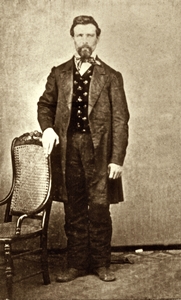 This copy of a carte de viste
This copy of a carte de viste
(CDV) is probably of John S. Bushong, Chester's father.
From the
J. H. Bushong Album. |
|
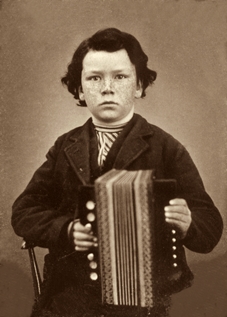 A young Hiram K. Bushong, Chester's
A young Hiram K. Bushong, Chester's
uncle and son of James and Drusilla
Stout Bushong. From a tintype, taken
in Ohio.
From the J.H. Bushong Album. |
|
His uncle, Hiram being around 40 years old and the senior partner in the show, became the Advance-booking agent, while the younger worked the magic lantern apparatus and slides. They developed a circuit and exhibited their show at village schoolhouses and other halls around the area. They'd been at it for some time and were about 100 miles away from Celina. In the last couple of weeks, they had little attendance and were pretty much broke. Hiram was trying hard to drum up business in a town for the show, and his efforts had paid off. They drew a crowded house, and with all the money from box office receipts, they were feeling very optimistic about their future. But a couple of the customers who were attracted by the crowd and the show turned out to be drunken cowboys, who started to shoot up the place and by the time they left the hall, they had stampeded the audience. When the dust had settled, every window in the room had been broken. Worse yet, the magic lantern itself had been damaged, beyond repair. To add to the disaster, during the melee, the money from the ticket sales had disappeared. After the incident, Chester and Hiram had few friends in town and could only head for home. Not only were they out of money but the Bushong Magic Lantern Show was out of business.1
|
Shortly after the magic lantern business calamity, Chester, who was still a boy, turned his interests to take the pictures instead of just showing them. He bought a camera and a darkroom outfit and opened a small studio. His self-education in photography brought disappointing results. So, looking to hone his art, he went to Denton, Texas, where he learned more about the business, and afterward returned to his native town to demonstrate his ability. He established a thriving and successful business but soon afterward sought a larger field. Over the next period, he leased various Texas studios at McKinney, Jefferson, eventually settling for a while in Van Alstyne, where he was the principal owner of the Bushong and Gray Studios. While in Van Alstyne, the striking photograph of Chester in a top hat, with his camera outfit, was taken. He later sold out to his partner, James L. Gray. The J. L. Gray funerary record is on Find a Grave, here.
In 1889 Chester moved to El Paso, where he became manager of the studio of Francis Parker. Shortly later he bought out Mr. Parker and the studio was named The Bushong Parker Studio.1
Along with his photo studio, Chester would find time for many passions, and one was still bicycling. In 1892, Chester helped found El Paso's Commercial Cycling Club, and their first meeting brought 26 new members.4 He was elected their first president. Chester was not only into cycling, being competitive, but he also raced. One of their races was known as the Ysleta to El Paso Road Race.1 The roads of the day were not much more than dirt paths, and the race to Ysleta, which was about fifteen miles distance, must have been filled with many bumps and surprises. Regardless, Chester won the race three times in succession.
|
|
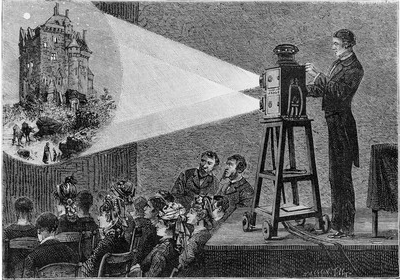 Chester may have visualized a more civilized clientele, than Texas cowboys, such as these, at a magic lantern show. This model lantern,
has dual lenses.
Chester may have visualized a more civilized clientele, than Texas cowboys, such as these, at a magic lantern show. This model lantern,
has dual lenses. |
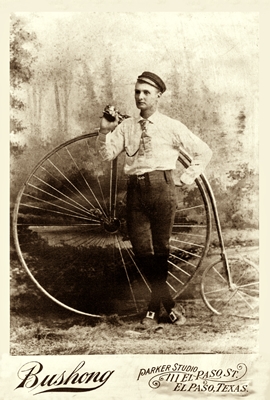 Probably one of Chester's friends in the El Paso Cycling Club. From Bushong-Parker Studio in about 1892.
Probably one of Chester's friends in the El Paso Cycling Club. From Bushong-Parker Studio in about 1892.
|
|
Later, after visiting the World's Fair in 1893 he decided to gain some additional experience in the Chicago studios, and while he was away, leased his El Paso studio, to Fred J. Feldman. For the next year or so, he operated studios, in Chicago, as well as others in St. Louis, New York, Boston, and Worcester, remaining in each city for a few months. Also while in Chicago, he took a course of study in the Chicago Art Museum. Chester returned to El Paso, and in 1895, formed a partnership with Mr. Feldman, who had become quite good, while running the studio. Chester's association with Mr. Feldman continued for five or six years and the studio would gain fame and garner awards. At first, just a photography studio, later Bushong and Feldman Studios, as they were called, added a line of photographic supplies, art goods, and Kodak cameras to their business.1 The Fred J. Feldman funerary record is on Find a Grave, here.
Another business venture Chester is said to have been involved in, was the Tracy Motor Company, which manufactured gas engines. He was co-founder and president of the corporation which was later reorganized as the El Paso City Foundry and Machine Company. When Chester moved to Worcester, he sold his interest to his partner.1
In 1897, Chester, who was always an adventurer, set off on a cross country trip. During a two week period, he drove a primitive automobile, over 400 miles on unpaved and sometimes nonexistent roads, that were not much more than paths, and had quite the adventure. Some of his exploits were reported in the El Paso Daily Herald.5
|
| |
An 1897 Oldsmobile, sporting hard rubber tires. |
A Pilgrim's Return
Mr. Bushong returned this morning via the T. & P. from the Panhandle, where he has been rusticating and enjoying himself for the last two weeks. He started, as per schedule, from Colorado City across the country to Plain view, 179 miles, and made it in three days. But on the return, Mr. Bushong found it was seventeen miles shorter to strike Big Springs, and he tried it. He did make 102 miles the first day; but then came grief and affliction, trials, and tribulations. He got mired in a slue that made him think of the slue of despond that he read of in Bunyan's Pilgrim's Progress when a kid, and after revolving many things in his mind as to how he should get out, chanced to see something that looked like a rope dangling near him. Mr. Bushong laid hold of the same and found it to be a mule's tail. He held on like grim death to a pale darkie and was yanked out of the mud by the excited animal along with his wheel.
|
Mr. Bushong thanked the mule kindly and tried to continue on the turf. But he got about 400 punctures or less in three minutes from the mesquite thorns. But with rare presence of mind, he did not pull the thorns out of his tire, but cut them off "close to the hub -with a razor and went on. The thorns staid in the rubber and did not come out, so the tires did not collapse. Mr. Bushong camped out in the brush overnight, and being short of matches, kindled a fire by the light of his countenance, and by rubbing two slicks together till the flame came. He shot several cottontail rabbits, skinned the same with the deftness of a chief and broiled the flesh. Unfortunately he had no butter, the skunks and prairie dogs stole it all the first night. Mr. Bushong got out of water. But as the dew fell copiously by night, he shook moisture out of the greasewood into his hat and poured it into his canteen until it was full.
Mr. Bushong has photographed all of his prairie experiences in his mind, and will reproduce the same through the camera for the delectation of his many friends. He reached Big Springs right side up with care, and slept all the way in. His riding covered 405 miles, "turnstile count."
El Paso Daily Herald
August 19, 1897
El Paso, Texas
|
A late 19th Century automobile, taken in 1900. This
vehicle had bicycle style inflatable tires such as
Chester described. Pictured here, Horace Dobbins, a former mayor of Pasadena, on a cycleway in Pasadena.
|
|
|
In El Paso, Chester was a member of many organizations, including the Volunteer Fire Department, where he was on Hose Company No. 1.6 He even performed in an opera, the H.M.S. Pinafore, in June of 1897, playing the part of the Sergeant of the Marines.7 With his new partner, Fred Feldman, they were members of the McGinty Club. The club was a prestigious fraternal and notorious drinking club of the 1890s in El Paso, that touted more than 300 members. Among them were lawyers, three mayors, three prominent bankers, several judges, the manager of Myar's Opera House, a tax assessor, two physicians, and "almost everybody who was anybody."8 The McGinty Club, probably at the behest of Chester, also sponsored bicycle races.8
But one of the McGinty Club's main interests was music. No less than, ten different bands and musical groups were spawned by the club. Among the brass bands, marching bands, and other groups were the McGinty Mandolin Quartet. Chester and partner, Mr. Feldman, were accomplished musicians, who were both members of the quartet. It was very well received and performed at Myar's Opera House, the El Paso Opera House, and other places.8; 9
|
|
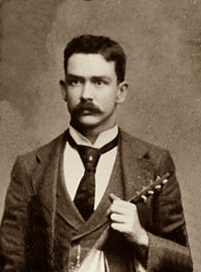 J.C. Bushong cropped from the McGinty String Band photograph.
J.C. Bushong cropped from the McGinty String Band photograph.
|
| |
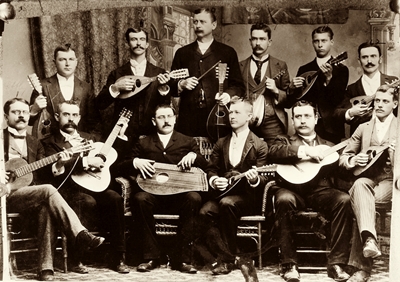 The McGinty String Band. Chester is back row, fourth from left.
The McGinty String Band. Chester is back row, fourth from left.
Taken in the 1890s.
|
|
The McGinty Mandolin Quartet
The McGinty mandolin quartet whose tuneful strains will be heard later on in the opera house. The members are Messrs. F. M. Rhomberg, first mandolin: Joseph Cooley, second mandolin: John C Bushong, third mandolin or mandola; Fred J. Feldman, guitar. Mr. Rhomberg, as was noted in yesterday's concert report, is a veteran in mandolin work, having belonged to the two largest mandolin orchestras in Chicago, viz. those of Tomaso and Hayes, besides playing slide trombone in the second regiment band. Mr. Rhomberg is an artist and as the leader of the reconstructed McGinty mandolin quartet, has brought the organization up to a high degree of efficiency. The other three players have long been known to the El Paso public and have always been welcomed, by local audiences. Mr. Cooley is receiving teller in the First National bank, Messrs. Bushong and Feldman are the well-known artist photographers, and all are ardent devotees at the shrine of the divine muse.
El Paso Daily Herald
April 07, 1897
|
|
|
The Photography Studio, of Bushong and Feldman, was very accomplished and prestigious and their photographs were displayed in competitions in America and Europe.10; 11 They competed in the American Photographer's Association, National Conventions in New York in 1896, 1897, and 1898 winning bronze medals in 1896 and 1897.10; 11; 12
But, perhaps one of their greatest successes was in 1898, at the National Convention, held in Celoron, New York. Chester attended for the studio and competed along with 175 other photographers from all over the country. The studio entered the Cabinet Photograph competition, that year, was a crowded field. The entries were to contain 12 cabinet photographs, all in one frame (without glass).13; 14; 15 A newspaper clipping illustrates just how excited they were to win the silver medal for first place in the prestigious competition.
|
|
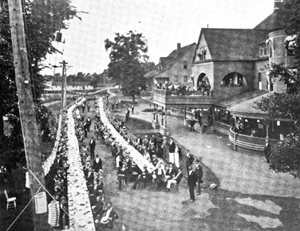 The 1898 National Photography Convention in Celoron, New York, the convention dinner, with 176 photographers in attendance.
The 1898 National Photography Convention in Celoron, New York, the convention dinner, with 176 photographers in attendance.
From Wilson's Photographic Magazine, Volume 35 Page 405
|
| |
The Silver Medal from the 1897 National Convention, Class D, Southern Division. |
|
The First Prize Goes to El Paso Photographers
Mr. Feldman is in receipt of a telegram from Mr. Bushong who is attending the Photographers association of America at Jamestown, N. Y., in which he says that the firm won the Silver Medal, 1st prize, for cabinet photos. There are four divisions to compete in, Eastern, Middle, Western and Southern divisions. In each of the divisions a bronze medal is given for 1st prize and then the winners from each division compete for the silver medal, which was won by Messrs. Bushong and Feldman of El Paso. The Southern division consists of all the states south of Virginia and east of New Mexico.
El Paso Daily Herald
July 14, 1898
3rd Edition
| |
|
In 1900 Chester moved to Worcester, Massachusetts. There, he met and on August 1, 1906, married, Kathryn Pauline Ryan, daughter of Michael Henry Ryan and Pauline C. Essig, of West Boylston. They made their home at No. 20 Fiske Street, and had one daughter, Pauline Vyletta, (Polly), in 1909, a son, John Richard, in 1912, and a son Robert R., (Bobby), in 1922.1; 2
Chester opened what was called a very artistic studio on Elm street. In 1905 he was elected vice-president of the New England Photographers Association, and was nominated for president the following year, but declined. He was later elected the president for the association in 1913. The building in which his studio was located was demolished to make way for the Slater building in 1906, and at that time he and Herman Schervee formed a partnership and they consolidated their business Schervee Studio at No. 328 Main Street, Worcester.1
|
|
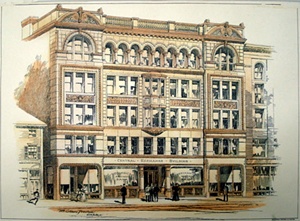
The Central Exchange Building, in Worcester,
where Chester's last studio was. He left work early
Dec 20, 1938 and died of
a heart attack that night.
|
During his career, Chester photographed many famous personalities and figures. But in September 1909, the studio of Schervee and Bushong was commissioned to take the group photo for a series of lectures at Clark University, Worcester, that was quite noteworthy. They were conducted by the Austrian neurologist Sigmund Freud, on the discipline of psychoanalysis at Clark's Psychology, Pedagogy, and School Hygiene Conference. So it was either Mr. Schervee or Chester who took the group portrait with forty-two participants that turned out to be a "who's who" of the pioneers of psychiatry and psychology, including Freud, Jung, Ferenczi, William James, Franz Boas, and others.16 The firm continued until 1910, at which time it was dissolved. After that Chester, operated a studio in the Central Exchange building, on Main Street,1; 17, and business was good. On December 20, 1938, Chester sadly died at his home in Worcester. He had been at work but left early, saying he was tired and died of a heart attack at six that evening.17 He was buried in the Mount Vernon Cemetery.18
|
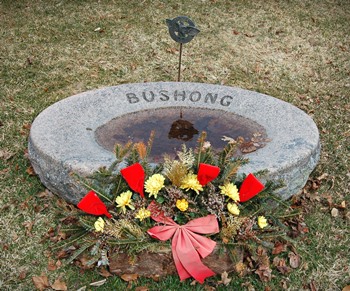
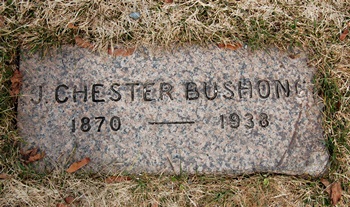 Chester's tombstones in the in the Mount Vernon Cemetery.
Chester's tombstones in the in the Mount Vernon Cemetery.
The brass marker is for a son's WWII service.
Photos by Dave Lindberg, West Boylston, MA, All Rights reserved. |
|
|
J.C. Bushong Dies Suddenly
One of the City's Oldest Photographers; Funeral Thursday
J. Chester Bushong 68, one of Worcester's oldest studio photographers, died of a heart ailment early last night at his home, 135 Richmond Avenue. Mr. Bushong was a charter member of the Worcester Country Club and of the Kiwanis Club, of which he was a past president. He had been in good health until late Monday afternoon when he left his studio earlier than usual and told members of his family that he was tired, attributing it to the holiday rush. Dr. George D. Kaneb attended him yesterday morning. At noon his condition took a turn for the worse and he lapsed into unconsciousness. He died shortly before 6 o'clock. His studio was in the Central Exchange Building, 311 Main Street, where he had been in business since 1910. Previous to that he was in partnership with the late Herman Schervee of the Schervee studio. Mr. Bushong had been in business here for 38 years. Funeral services will be held at the Putnam Funeral Parlors, 866 Main Street, Thursday at 2 pm Rev. George E Heath of Wesley M. E. Church will officiate. Calling hours at the home, 135 Richmond Avenue, will be 7 to 9 pm Wednesday.
Mr. Bushong first came to Worcester in 1898 to manage the Schervee studio while Mr. Schervee went abroad. Mr. Schervee had persuaded him to come here when they met at a national photograph convention in New York. A Westerner by birth, Mr. Bushong, later selected Worcester as his home after what he often said was a search from San Francisco to Boston. He was born in Columbus Grove, Ohio, the son of the late John S and the late Vylette (Rice) Bushong. He leaves his wife, Kathryn P. (Ryan) Bushong; a daughter (Polly); two sons,(Richard and Bobby); a brother, Herbert Bushong, and two sisters, Elizabeth, wife of John Clardy, and Letty, wife of Elmer Baker, the latter three of Dallas, Texas. His father owned a large cattle ranch in the West.
Worcester Telegram, Worcester, Massachusetts, December 21, 1938, page 1
|
|
John Chester Bushong was a photographer and artist, who worked right up to the end, and it is easy to understand why two of his children became artists, both famous in their own right. His daughter, Polly, was a well-known portrait photographer, painter, and performance artist, as the be-wigged and buck-toothed character, Cora Pratt. His son, Bobby, was a successful artist, who painted many notable works for Tom Tru Corporation. Moving to Nantucket Island in 1955, both Polly and Bobby helped craft the social circuit of artists that dominated the island in the 1960s. Their art, today, is considered very collectible when it can be found.
|
References:
- Historic Homes and Institutions and Genealogical and Personal Memoirs,
By Ellery Bicknell Crane, Volume 4
Page 300, 301
- Bushong United Family Tree Search
- Wikipedia Penny-farthing. here.
- El Paso International Daily Times, El Paso, Texas, July 15, 1892, (page 7)
- El Paso Daily Herald, El Paso, Texas, August 19, 1897
- El Paso Daily Herald, El Paso, Texas, May 13, 1897, Firemen's Special Edition
- El Paso Daily Herald, May 31, 1897
- Texas Historical Association The McGinty Club
- To the Stars Over Rough Roads, By Donald Frederick Nelson page 147
- El Paso Daily Herald, November 23, 1897
- El Paso Daily Herald, December 10, 1897
- El Paso Daily Herald, November 03, 1897
- Photo Beacon Volume 10, Page 32
- From Wilson's Photographic Magazine, Volume 35 Page 405
- Photo-era Magazine, Volumes 1-2 Page 83
- Yale University Beinecke Rare Books & Manuscript Library Sigmund Freud Convention Sept. 1909
- Obituary, Worcester Telegram, Worcester, Massachusetts, Dec 21, 1938, page 1
- John Chester Bushong's funerary record on Find a Grave, here
|
|
A magic lantern set, using only
a single lens.
|
|
Bushong United is Copyright ©2022-2023 by
Rick Bushong any Commercial Use is Prohibited.
Non-commercial use is allowed with permission or only if entire
copyright is included.
Photographs, unless otherwise noted, are in the commons, and are free use. No Bandwidth Theft Allowed.
To Direct Search the Bushong United Family Tree
click here
|

